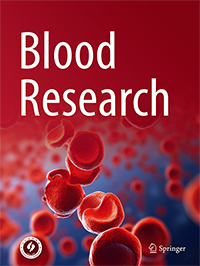Original Article
 Split Viewer
Split Viewer
Korean J Hematol 2010; 45(1):
Published online March 31, 2010
https://doi.org/10.5045/kjh.2010.45.1.62
© The Korean Society of Hematology
Neostigmine for the treatment of acute colonic pseudo-obstruction (ACPO) in pediatric hematologic malignancies
1Department of Pediatrics, College of Medicine, The Catholic University of Korea, Seoul, Korea.
2Department of Radiology, College of Medicine, The Catholic University of Korea, Seoul, Korea.
Correspondence to : Correspondence to Bin Cho, M.D., Ph.D. Pediatrics, Seoul St. Mary' Hospital, The Catholic University of Korea, 505 Banpo-dong, Seocho-gu, Seoul 137-701, Korea. Tel: +82-2-2258-6187, Fax: +82-2-537-4544, chobinkr@catholic.ac.kr
This is an Open Access article distributed under the terms of the Creative Commons Attribution Non-Commercial License (http://creativecommons.org/licenses/by-nc/3.0/) which permits unrestricted non-commercial use, distribution, and reproduction in any medium, provided the original work is properly cited.
Background
Acute colonic pseudo-obstruction (ACPO) refers to dilatation of the colon and decreased bowel motility without evidence of mechanical obstruction. Neostigmine, an acetylcholinesterase inhibitor, has been used in patients in whom supportive therapy failed to resolve ACPO. Here, we report the results of administering neostigmine to treat ACPO in children with hematologic malignancies.
Methods
Between September 2005 and December 2009, 10 patients (8 male and 2 female) were diagnosed with ACPO at the Department of Pediatrics, Catholic University of Korea. Diagnosis of ACPO was based on typical clinical features as well as colonic dilatation found on abdominal CT imaging. Neostigmine was administered subcutaneously at a dosage of 0.01 mg/kg/dose (maximum 0.5 mg) twice daily for a maximum of 5 total doses. ACPO was determined to be responsive to neostigmine if the patient showed both stool passage and improvement of clinical symptoms.
Results
The study group included 8 acute lymphoblastic leukemia patients, 1 patient with malignant lymphoma, and 1 patient with juvenile myelomonocytic leukemia. The median age at ACPO diagnosis was 8.5 years (range, 3-14). Overall, 8 patients (80%) showed therapeutic response to neostigmine at a median of 29 hours after the initial administration (range, 1-70). Two patients (20%) showed side effects of grade 2 or above, but none complained of cardiovascular symptoms that required treatment.
Conclusion
In this study, ACPO was diagnosed most often in late-childhood ALL patients. Subcutaneous neostigmine can be used to effectively treat ACPO diagnosed in children with hematologic malignancies without major cardiovascular complications.
Keywords Acute colonic pseudo-obstruction, Neostigmine, Children, Hematologic malignancies
Article
Original Article
Korean J Hematol 2010; 45(1): 62-65
Published online March 31, 2010 https://doi.org/10.5045/kjh.2010.45.1.62
Copyright © The Korean Society of Hematology.
Neostigmine for the treatment of acute colonic pseudo-obstruction (ACPO) in pediatric hematologic malignancies
Jae-Wook Lee1, Kyong-Won Bang1, Pil-Sang Jang1, Nak-Gyun Chung1, Bin Cho1*, Dae-Chul Jeong1, Hack-Ki Kim1, Soo-Ah Im2, and Gye-Yeon Lim2
1Department of Pediatrics, College of Medicine, The Catholic University of Korea, Seoul, Korea.
2Department of Radiology, College of Medicine, The Catholic University of Korea, Seoul, Korea.
Correspondence to:Correspondence to Bin Cho, M.D., Ph.D. Pediatrics, Seoul St. Mary' Hospital, The Catholic University of Korea, 505 Banpo-dong, Seocho-gu, Seoul 137-701, Korea. Tel: +82-2-2258-6187, Fax: +82-2-537-4544, chobinkr@catholic.ac.kr
This is an Open Access article distributed under the terms of the Creative Commons Attribution Non-Commercial License (http://creativecommons.org/licenses/by-nc/3.0/) which permits unrestricted non-commercial use, distribution, and reproduction in any medium, provided the original work is properly cited.
Abstract
Background
Acute colonic pseudo-obstruction (ACPO) refers to dilatation of the colon and decreased bowel motility without evidence of mechanical obstruction. Neostigmine, an acetylcholinesterase inhibitor, has been used in patients in whom supportive therapy failed to resolve ACPO. Here, we report the results of administering neostigmine to treat ACPO in children with hematologic malignancies.
Methods
Between September 2005 and December 2009, 10 patients (8 male and 2 female) were diagnosed with ACPO at the Department of Pediatrics, Catholic University of Korea. Diagnosis of ACPO was based on typical clinical features as well as colonic dilatation found on abdominal CT imaging. Neostigmine was administered subcutaneously at a dosage of 0.01 mg/kg/dose (maximum 0.5 mg) twice daily for a maximum of 5 total doses. ACPO was determined to be responsive to neostigmine if the patient showed both stool passage and improvement of clinical symptoms.
Results
The study group included 8 acute lymphoblastic leukemia patients, 1 patient with malignant lymphoma, and 1 patient with juvenile myelomonocytic leukemia. The median age at ACPO diagnosis was 8.5 years (range, 3-14). Overall, 8 patients (80%) showed therapeutic response to neostigmine at a median of 29 hours after the initial administration (range, 1-70). Two patients (20%) showed side effects of grade 2 or above, but none complained of cardiovascular symptoms that required treatment.
Conclusion
In this study, ACPO was diagnosed most often in late-childhood ALL patients. Subcutaneous neostigmine can be used to effectively treat ACPO diagnosed in children with hematologic malignancies without major cardiovascular complications.
Keywords: Acute colonic pseudo-obstruction, Neostigmine, Children, Hematologic malignancies
Fig 1.

An 11-year-old male patient diagnosed with Philadelphia chromosome-positive ALL failed to pass stools for 157 hours before an abdominal CT was undertaken. Initial imaging showed massive colonic dilatation and fecal impaction consistent with ACPO, with the maximum diameter of the ascending colon measuring approximately 6.7 cm
-
Table 1 . Demographic characteristics of the study group (N=10)..
Abbreviations: ACPO, acute colonic pseudo-obstruction; ALL, acute lymphoblastic leukemia; DLBL, diffuse large B-cell lymphoma; JMMoL, juvenile myelomonocytic leukemia..
-
Table 2 . Patient history at ACPO diagnosis (N=10)..
-
Table 3 . Neostigmine administration and response (N=10)..

Article Tools
Stats or Metrics
Related articles in BR
-
Genomic testing for germline predisposition to hematologic malignancies
Sang Mee Hwang
Blood Res 2024; 59(): -
Prognostic impact of total body irradiation dose in pediatric acute lymphoblastic leukemia patients treated with allogeneic hematopoietic stem cell transplantation in second complete remission
Wonjin Jang, Suejung Jo, Jae Won Yoo, Seongkoo Kim, Jae Wook Lee, Pil-Sang Jang, Nack-Gyun Chung, Bin Cho
Blood Res 2022; 57(4): 256-263 -
Chest multidetector computed tomography imaging of COVID-19 pneumonia patients with hematologic malignancies
Adel El-Badrawy, Nada Elbadrawy
Blood Res 2022; 57(3): 216-222




 PDF
PDF Standard view
Standard view Export citation
Export citation Share
Share  Download
Download Previous Article
Previous Article



